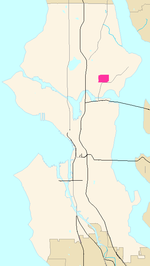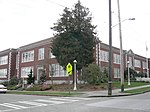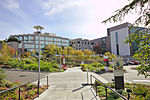Calvary Cemetery (Seattle)

Calvary Cemetery is a Roman Catholic cemetery in Seattle, Washington, United States, located in the Ravenna/Bryant neighborhood. Dedicated on December 1, 1889, it is situated on the southwest slope of a hill overlooking University Village, about a mile (1.6 km) northeast of the University of Washington. It is owned and operated by the Archdiocese of Seattle. Covering an area of 40 acres (16 ha), the square-shaped cemetery is bounded on the north by N.E. 55th Street, on the east by 35th Avenue N.E., on the south by N.E. 50th Street, and on the west by 30th Avenue N.E. Around 40,000 people are buried in its grounds, including: Vivian E. Albertson, Bellevue School District director from 1982 to 1990 Dave Beck, former president of the Teamsters "Tioga George" Burns, baseball player, the American League's most valuable player in 1926. John Cherberg, lieutenant governor for 32 years, UW football player and head coach Raymond E. Davis, Medal of Honor recipient in 1905 Hec Edmundson, basketball and track coach at the University of Washington Walter Galbraith, former president of Galbraith and Co. and director of Washington Mutual Tubby Graves, baseball head coach at UW Michael J. "Moose" Heney, Alaskan railroad builder Al Hostak, middleweight boxer Jacob Nist, founder of Queen City Manufacturing Company, now the Seattle-Tacoma Box Company Edward Nordhoff, founder of The Bon Marché department store chain William Piggott, founder of Paccar Albert Rosellini, former governorAdditionally, priests of the Archdiocese of Seattle and clergy from a number of religious orders are buried at the cemetery. There is one British Commonwealth war grave, of a Canadian Army soldier of World War I.
Excerpt from the Wikipedia article Calvary Cemetery (Seattle) (License: CC BY-SA 3.0, Authors, Images).Calvary Cemetery (Seattle)
Northeast 55th Street, Seattle University District
Geographical coordinates (GPS) Address Nearby Places Show on map
Geographical coordinates (GPS)
| Latitude | Longitude |
|---|---|
| N 47.667 ° | E -122.293 ° |
Address
Northeast 55th Street
Northeast 55th Street
98105 Seattle, University District
Washington, United States
Open on Google Maps








